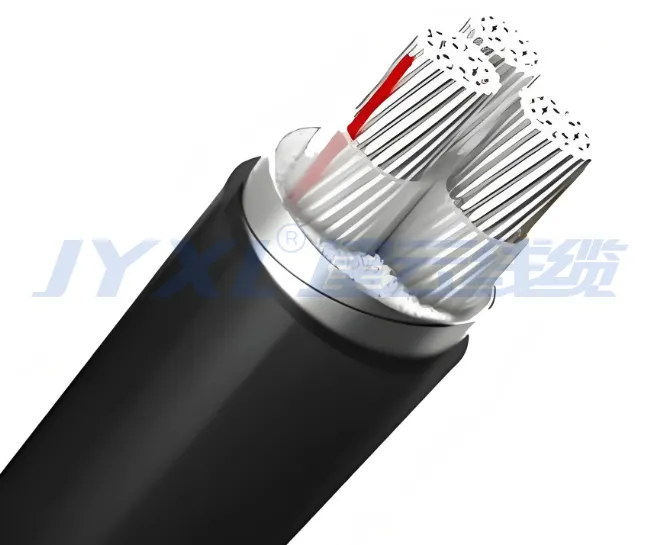Time: 2025-06-12 14:48:42 Source: Henan Province Jianyun Cable Co., Ltd.

Armored cables incorporate an additional protective layer, often made of steel or aluminum, and occasionally non-metallic materials such as Kevlar, providing mechanical strength. Unarmored cables consist of insulated conductors encased in a non-metallic jacket, such as PVC or rubber, without this additional protection.
Armored cables are typically deployed in industrial, outdoor, or underground environments where they may be exposed to mechanical damage or moisture. Unarmored cables are used in indoor settings, such as within walls or conduits, where protection requirements are minimal.
Armored cables are generally more expensive due to their additional protective layer and are less flexible, requiring a larger bending radius. Unarmored cables are more cost-effective and flexible, facilitating installation in confined spaces.
This analysis provides a comprehensive comparison of armored and unarmored cables, addressing construction, protection levels, applications, flexibility, cost, grounding, durability, and practical considerations for selection.
Armored cables are distinguished by an additional protective layer, typically constructed from steel or aluminum, encasing the insulated conductors. This layer, known as armoring, may also include non-metallic materials such as Kevlar, fiber yarn, or glass yarn. Steel wire or tape armoring is common, offering varying degrees of protection. This armoring enhances mechanical strength and resistance to corrosion, enabling the cable to withstand physical stress.
Unarmored cables, in contrast, lack this protective layer, comprising only insulated conductors within a non-metallic outer jacket, such as PVC or rubber. This simpler construction makes them more susceptible to external damage but easier to manufacture and install.
The protective layer of armored cables significantly enhances their resistance to mechanical damage, including impacts, crushing, and abrasion. This layer also provides protection against moisture and environmental hazards, with some designs incorporating flooding compounds to prevent water ingress. Armored cables are further resistant to rodent damage, extending their service life.
Unarmored cables offer only basic insulation, making them vulnerable to mechanical damage and harsh environmental conditions. They are unsuitable for direct burial or exposure to moisture, limiting their use to protected environments.
Armored cables are designed for harsh environments where mechanical stress is a concern. They are commonly used in industrial settings, outdoor installations, and underground wiring, where they can be installed in various configurations, including rapid deployment in rocky terrains. They are also employed in high-tension (HT) and low-tension (LT) distribution and radio frequency (RF) environments for additional grounding protection. Armored cables are ideal for direct burial, safeguarding against environmental factors such as moisture and rodent activity.
Unarmored cables are typically used in protected environments, such as within walls, conduits, or residential wiring. They are suitable for less demanding applications where cables are shielded from external damage, such as control systems within buildings.
Due to their rigid armoring, armored cables are less flexible, requiring a larger bending radius for installation. This can complicate routing in confined spaces. However, certain armoring designs, such as ribbed aluminum foil, offer limited flexibility.
Unarmored cables, lacking armoring, are highly flexible, facilitating installation in tight areas. This flexibility is a key advantage, making them preferable for residential and light commercial applications.
Armored cables are generally more expensive due to the additional materials and manufacturing complexity, with market prices approximately 15% higher than unarmored cables. Armored cables with Kevlar are particularly costly, reserved for specialized applications, while steel strip and aluminum options are more economical.
Unarmored cables, with their simpler construction, are less expensive, making them a cost-effective choice for applications with minimal protection requirements.
The metal armoring in armored cables can serve as a grounding path, enhancing electrical safety. Some designs include a small metal ribbon to ensure electrical continuity, particularly beneficial in RF environments for safety grounding.
Unarmored cables require a separate grounding conductor, which may increase installation complexity in certain scenarios.
Armored cables are renowned for their durability, resisting tensile and compressive forces and protecting against rodent damage, thereby extending service life. They are particularly suited for direct burial applications.
Unarmored cables, while functional in protected environments, are less durable and more susceptible to damage from external factors.
Both cable types can handle high voltages up to 30kV. However, armored cables are typically designed for higher-stress environments, offering a practical advantage in voltage applications under harsh conditions.
When selecting between armored and unarmored cables, consider the environmental and application requirements. Armored cables are recommended for installations exposed to mechanical damage, moisture, or harsh conditions, such as industrial facilities, outdoor settings, or underground wiring. Unarmored cables are suitable for cost-effective installations in protected environments, such as within walls or conduits, where flexibility and ease of installation are priorities. Always ensure compliance with local electrical codes and consult a licensed electrician for specific applications.
| Feature | Armored Cable | Unarmored Cable |
|---|---|---|
| Construction | Includes metal or other armoring (e.g., Kevlar) | Non-metallic jacket, no armoring |
| Protection | High (mechanical, moisture, rodent) | Low (basic insulation) |
| Applications | Harsh environments (industrial, outdoor) | Protected settings (indoor, conduits) |
| Flexibility | Lower, requires larger bending radius | Higher, easier to install |
| Cost | Higher (approximately 15% more than unarmored) | Lower, cost-effective |
| Grounding | Armoring can serve as ground | Requires separate grounding conductor |
| Durability | High, extended service life | Lower, susceptible to damage |
| Voltage Rating | Up to 30kV, suitable for high stress | Up to 30kV, for protected use |